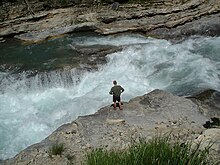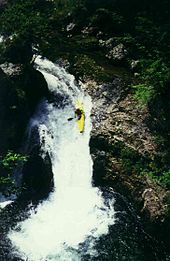wild Water
With white water is called a body of water with fast currents , strong cross-currents, eddies , rapids and partly waterfalls .
Natural white water
Whitewater is created when there is a sufficient gradient and / or narrowing of the watercourse (mostly due to rocks), which means that the water can no longer flow in a laminar manner . In addition, the slope of the landscape is decisive for the intensity of the current. Most white water is formed by natural or semi-natural rivers .
Artificial white water
More recently, artificial whitewater systems have also been built for whitewater sports, especially canoeing competitions, canoe slalom and whitewater racing - or watercourses with sufficient gradients have been expanded into whitewater courses through additional obstacles (mostly rocks).
Well known in Germany are the Augsburger Eiskanal and the Markkleeberg Canoe Park . In Hagen there is a section of the Lenne that has been upgraded to white water .
In Austria there is the “Verbund-Wasserarena” in Vienna (opened in 2013).
In Switzerland, a stretch of the Limmat was developed as white water in Baden .
Whitewater sports
If the water volume and width is sufficient, white water can be used to practice white water sports. Well-known sports are whitewater paddling , playboating , hydrospeed , sit-on-top and rafting , as well as for training and competitions in whitewater racing , canoe slalom and freestyle . In this context, white water is rated using the white water difficulty scale.

